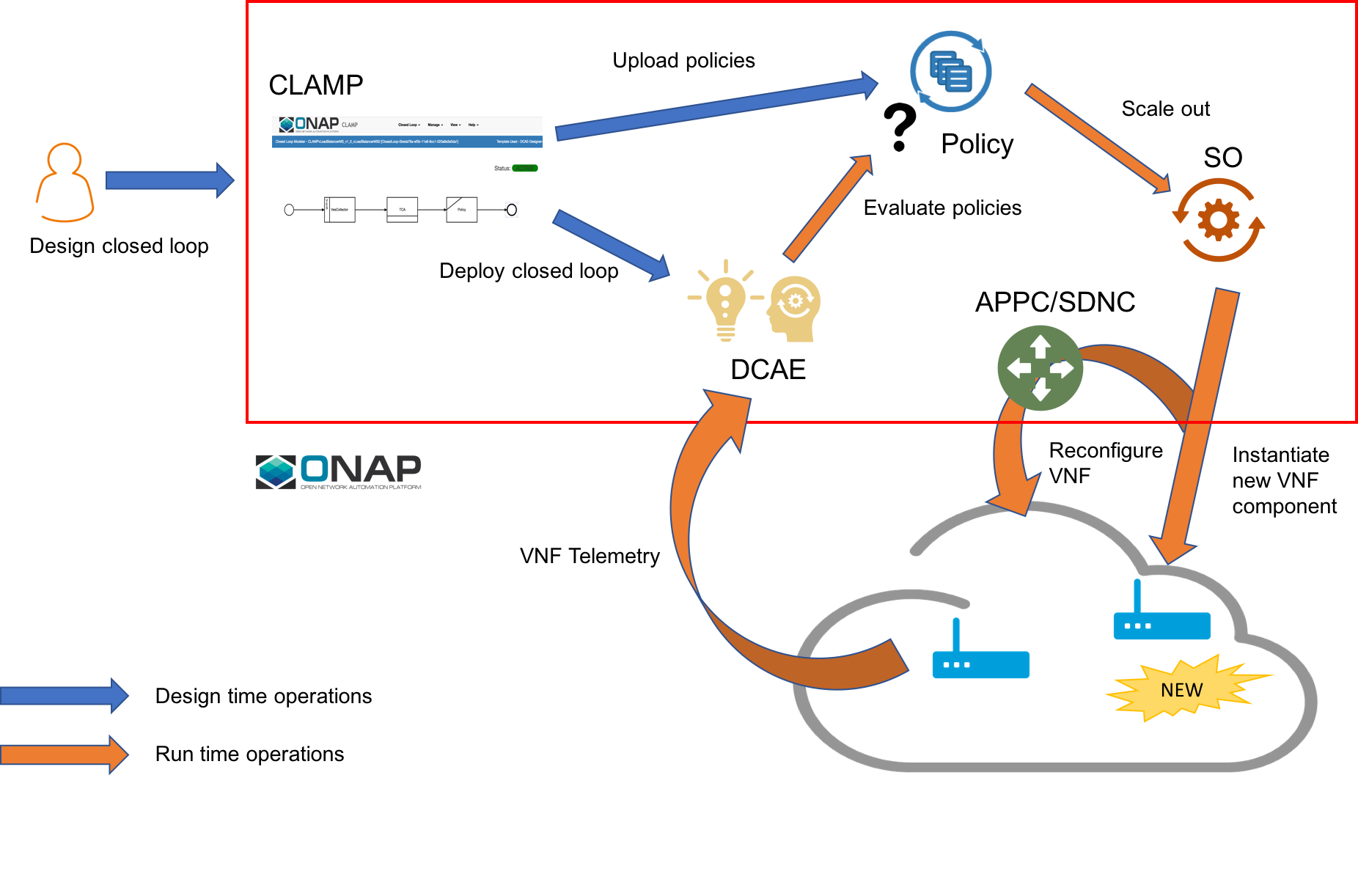ONAP Casablanca Release delivers platform capabilities that support scaling up resources. The use case has been designed and implemented to fully take advantage of existing functionalities, using newer APIs and technologies whenever possible. Compared to the previous version delivered for Beijing, which supported only manual trigger and one VNF type, the new use case adds:
- A design phase in which users define and deploy policies and closed-loops from CLAMP;
- Closed-loop- and Policy-based automation;
- Guard policies that allow/deny scale out operations based on frequency limits or max number of instances already scaled;
- New and improved workflow that leverages SO ability to compose building blocks on the fly;
- Use of Generic Resource APIs for VNF instantiation and lifecycle management (as opposed to the old VNF APIs);
- VNF health check;
- Support for multiple VNF types;
- Support for multiple VNF controllers, i.e. APPC (officially supported) and SDNC (experimental);
- Ability to define lifecycle management configuration from CLAMP (automated trigger) or VID (manual trigger).
This is a different kind of Use Case for ONAP that Integrates many of the projects to show how they can work together to perform a complex but essential activity.
The use case has been successfully demonstrated against docker images released for Casablanca, using the vLB/vDNS VNFs available in the Demo repository in Gerrit (https://gerrit.onap.org/r/gitweb?p=demo.git;a=tree;f=heat/vLBMS;h=37f803e33c6e1e41c3e7c5b009feeb7e3e1953d0;hb=refs/heads/casablanca).
Scale out with manual trigger
Closed loop-enabled scale out
Known Issues and Resolutions
1) When running closed loop-enabled scale out, the closed loop designed in CLAMP conflicts with the default closed loop defined for the old vLB/vDNS use case
Resolution: Change TCA configuration for the old vLB/vDNS use case
- Connect to Consul: http://<ANY K8S VM IP ADDRESS>:30270 and click on "Key/Value" → "dcae-tca-analytics"
- Change "eventName" in the vLB default policy to something different, for example "vLB" instead of the default value "vLoadBalancer"
- Change "subscriberConsumerGroup" in the TCA configuration to something different, for example "OpenDCAE-c13" instead of the default value "OpenDCAE-c12"
- Click "UPDATE" to upload the new TCA configuration
2) When running closed loop-enabled scale out, the permitAll guard policy conflicts with the scale out guard policy
Resolution: Undeploy the permitAll guard policy
- Connect to the Policy GUI, either through the ONAP Portal (https://portal.api.simpledemo.onap.org:30225/ONAPPORTAL/login.htm) or directly (https://policy.api.simpledemo.onap.org:30219/onap/login.htm)
- If using the ONAP Portal, use demo/demo123456! as credentials, otherwise, if accessing Policy GUI directly, use demo/demo
- Click "Policy" → "Push" on the left panel
- Click the pencil symbol next to "default" in the PDP Groups table
- Select "Decision_AllPermitGuard"
- Click "Remove"
3) When using SDNC, the JSON template for DMaaP messages has a wrong "input" field
Resolution: Replace the "input" field in the JSON template with "output"
- Connect to the SDNC container from the Rancher VM in the Kubernetes cluster, for example kubectl exec -it -n onap dev-sdnc-sdnc-0 bash
- Install your favorite text editor, for example apt-get update; apt-get install vim -y
Open /opt/onap/sdnc/restapi/templates/lcm-dmaap-publish-template.json and replace "input" with "output" in the JSON object body
Save the changes
If SDNC is deployed in cluster mode (3 SDNC replicas, dev-sdnc-sdnc-0, dev-sdnc-sdnc-1, dev-sdnc-sdnc-2), apply the same change to all the replicas in the cluster
4) When using SDNC, the JSON template for DMaaP messages has an extra newline at the end of the file
Resolution: Delete the extra newline
- Connect to the SDNC container from the Rancher VM in the Kubernetes cluster, for example kubectl exec -it -n onap dev-sdnc-sdnc-0 bash
- Install your favorite text editor, for example apt-get update; apt-get install vim -y
Open /opt/onap/sdnc/restapi/templates/lcm-dmaap-publish-template.json and execute the following operations:
:set binary
- :set noeol
- :wq
- If SDNC is deployed in cluster mode (3 SDNC replicas, dev-sdnc-sdnc-0, dev-sdnc-sdnc-1, dev-sdnc-sdnc-2), apply the same change to all the replicas in the cluster
Videos:
These videos provide a detailed documentation of how to run scale out use case using manual or automated (i.e. closed loop-enabled) trigger:
Material Used for the Demo
Heat templates for the vLB/vDNS VNFs: vLBMS.zip
DCAE Blueprint: tca_docker_k8s_v4.yaml
SDNC preload for the base VNF: base_preload.txt
SDNC preload of the scaling VF module (must be updated for each VF module): scaleout_preload.txt
Example of SDNC VF module topology to define a JSON path to configuration parameters for scale out: sdnc_resource_example.txt
Configuration parameters for CDT: parameters_vLB.yaml
VNF interface for CDT: Vloadbalancerms..dnsscaling..module-1.xml
AAI API to set Availability Zone:
CloudOwner is the cloud-owner object in AAI
- RegionOne is the cloud-region-id in AAI
- AZ1 is the name of the Availability Zone
curl -X PUT \
https://10.12.7.29:30233/aai/v14/cloud-infrastructure/cloud-regions/cloud-region/CloudOwner/RegionOne/availability-zones/availability-zone/AZ1 \
-H 'Accept: application/json' \
-H 'Content-Type: application/json' \
-H 'Postman-Token: 4fe938e9-28d7-4956-8822-e01b6f27a894' \
-H 'X-FromAppId: AAI' \
-H 'X-TransactionId: get_aai_subscr' \
-H 'cache-control: no-cache' \
-d '{
"availability-zone-name": "AZ1",
"hypervisor-type": "hypervisor"
}'
VID API to enable scale out for a given VNF:
- UUID is the VNF model version ID in the CSAR file
- invariantUUID is the VNF model invariant ID in the CSAR file
curl -X POST \
https://<ANY K8S VM IP ADDRESS>:30200/vid/change-management/vnf_workflow_relation \
-H 'Accept-Encoding: gzip, deflate' \
-H 'Content-Type: application/json' \
-H 'Postman-Token: 7086e3eb-f6a9-416c-85f9-6c99ae7c2c02' \
-H 'cache-control: no-cache' \
-d '{
"workflowsDetails":[
{
"workflowName":"VNF Scale Out",
"vnfDetails":{
"UUID":"d5c2aff0-d2bc-401e-8277-fd90c1351b0e",
"invariantUUID":"cdc1ac36-a3c9-41e8-872b-10d02a6eded1"
}
}
]
}'
Configuration parameters:
Define a JSON path to "vdns_private_ip_0", "vdns_private_ip_1", and "enabled". Use the following formats for VID and Policy:
VID:
[{"ip-addr":"$.vf-module-topology.vf-module-parameters.param[10].value","oam-ip-addr":"$.vf-module-topology.vf-module-parameters.param[15].value","enabled":"$.vf-module-topology.vf-module-parameters.param[22].value"}]
POLICY:
requestParameters: '{"usePreload":true,"userParams":[]}'
configurationParameters: '[{"ip-addr":"$.vf-module-topology.vf-module-parameters.param[10].value","oam-ip-addr":"$.vf-module-topology.vf-module-parameters.param[15].value","enabled":"$.vf-module-topology.vf-module-parameters.param[22].value"}]'

